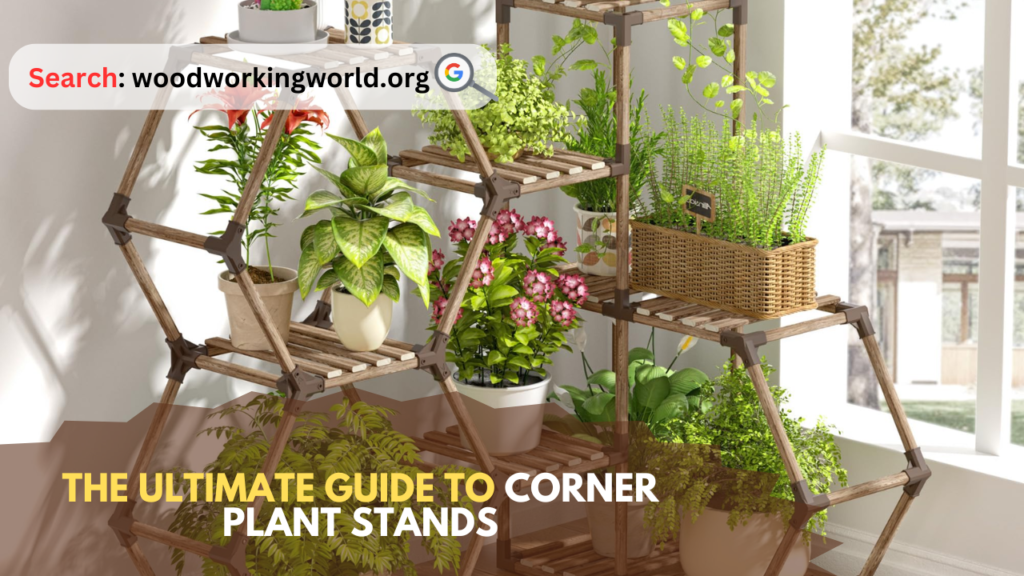The Ultimate Guide to Corner Plant Stands
Introduction to Corner Plant Stands
Corner plant stands are a fantastic way to display your plants while making the most of the often-overlooked corners of your home. They’re perfect for small spaces, adding a touch of greenery without occupying precious floor area. Whether you’re an avid plant lover or simply looking to add more life to your space, corner plant stands are a stylish and functional solution.

Why Choose a Corner Plant Stand?
Corner plant stands are specifically designed to make use of the empty corners in your home. They are an excellent way to add height and interest to any room while making efficient use of space. By positioning plants in corners, you can create a more open, less cluttered living area. These stands also allow you to elevate plants to improve their exposure to light and make them a centerpiece in your décor.
Materials for Building Corner Plant Stands
Wood
Wood is a timeless material for corner plant stands. It provides a warm, natural look and can be easily customized to suit any décor style. Whether you’re going for rustic, modern, or traditional, wood is versatile and easy to work with.
Metal
For a sleek and industrial look, metal is a great choice. Metal plant stands are durable and can hold heavy plants. They work especially well in modern or minimalist homes.
Plastic
Plastic is lightweight, affordable, and comes in various designs and colors. It’s an ideal choice for smaller plants or when you want a budget-friendly solution that doesn’t compromise on style.
Bamboo
Bamboo is a sustainable and eco-friendly option. It’s lightweight yet sturdy, making it an excellent material for corner plant stands that require flexibility and natural beauty.
Start Your Next Project With Teds’ Archive Of 16,000 Plans!
Instant access to all 16,000 woodworking plans with step-by-step details, photos, materials lists and more
Monthly free plans with lifetime membership access – No renewals, recurring fees or other charges

Types of Corner Plant Stands
Tiered Corner Plant Stand
A tiered stand allows you to display multiple plants in a compact space. With shelves that gradually decrease in size as they go up, tiered corner stands create a cascading effect that’s perfect for showcasing a variety of plant heights.
Rotating Corner Plant Stand
A rotating stand is ideal for those who want easy access to all their plants. It’s perfect for small spaces where you may need to rotate plants to get the best exposure to light or to display plants in a dynamic way.
Hanging Corner Plant Stand
This type of stand uses wall-mounted brackets or hooks to hang plants in the corner. It’s great for freeing up floor space and adding a floating effect that brings attention to the plants while maintaining an open environment.
Adjustable Corner Plant Stand
An adjustable corner stand can change its height or configuration to fit the size and shape of your plants. This flexibility is ideal if you plan to rotate or change the arrangement of your plants frequently.
How to Build a DIY Corner Plant Stand
Step-by-Step Guide for a Wooden Corner Stand
- Materials Needed: Wood boards, nails or screws, measuring tape, saw, wood finish.
- Instructions:
- Cut the wood into the desired dimensions for the base and shelves.
- Attach the shelves to the frame with nails or screws.
- Sand and finish the wood to your liking.
Creating a Metal Corner Stand
- Materials Needed: Metal pipes, brackets, screws, pipe cutter.
- Instructions:
- Measure the height and width of your corner space.
- Cut the metal pipes and connect them using the brackets.
- Assemble the frame and secure it to the wall for added stability.
Simple Hanging Corner Plant Stand Tutorial
- Materials Needed: Rope or chain, hooks, small wooden shelf.
- Instructions:
- Install hooks in the ceiling or wall corner.
- Attach the shelf with rope or chain and hang the plants.
Tips for Choosing the Right Corner Plant Stand
Size and Space Considerations
Before buying or building your corner plant stand, measure the space to ensure it fits comfortably. A stand that is too large can overwhelm the corner, while one that’s too small won’t effectively showcase your plants.
Style and Aesthetic
Consider the design and material of the stand. A modern metal stand may suit a contemporary space, while a wooden stand fits more rustic or traditional décor. Choose a style that complements your overall interior design.
Stability and Durability
Ensure the stand is sturdy enough to hold the weight of your plants. Check that it has proper support, especially if you’re using tiered shelves, to avoid accidents or damage to your plants.
Benefits of Using a Corner Plant Stand
Maximizing Space
One of the key benefits of a corner plant stand is maximizing your room’s space. By utilizing empty corners, you free up valuable floor space and keep your living area looking tidy.
Improving Plant Health
Elevating your plants can provide them with better light exposure, which is essential for healthy growth. Corner plant stands can help you place your plants in spots where they will thrive, especially if your home has limited natural light.
Enhancing Room Aesthetics
A well-designed plant stand adds an artistic touch to your décor. Whether you prefer a minimalist look or a vibrant, boho vibe, corner plant stands can enhance the beauty of any room.
Where to Place Your Corner Plant Stand
Living Room
The living room is an excellent place for a corner plant stand, especially in a corner near a window. It will help create a cozy, welcoming atmosphere while showcasing your plants.
Bedroom
Placing a corner plant stand in your bedroom can add a touch of tranquility and nature, creating a relaxing environment perfect for unwinding after a long day.
Office and Other Spaces
Corner plant stands are perfect for offices, where they help reduce stress and improve productivity. In addition, they can also add a calming vibe to other areas of the home, such as hallways or entryways.
Common Mistakes to Avoid with Corner Plant Stands
Choosing the Wrong Size
Make sure the stand fits well in the corner. A stand that’s too large can make the room feel cramped, while a small stand may not be able to hold your plants effectively.
Ignoring the Weight Capacity
Each plant stand has a weight limit. Overloading the stand can cause instability, leading to potential accidents.
Poor Stability
If your stand is wobbly or unstable, your plants are at risk of falling. Always ensure the stand is properly assembled and securely placed.
Conclusion
Corner plant stands are a simple yet effective way to incorporate plants into your home without sacrificing space. Whether you buy one or make your own, a corner plant stand can add style, function, and beauty to any room. So, why not take advantage of those empty corners and turn them into a lush, green sanctuary?
FAQs
1. What is the best material for a corner plant stand?
The best material depends on your style and the weight of your plants. Wood, metal, and bamboo are popular choices, with wood being ideal for a rustic look, metal for an industrial feel, and bamboo for a sustainable touch.
2. Can I make my own corner plant stand?
Absolutely! DIY corner plant stands are an easy and affordable way to personalize your home. Use materials like wood or metal to create a stand that fits your corner space perfectly.
3. How many plants can I fit on a corner plant stand?
This depends on the size and design of the stand. Tiered stands can hold several plants, while single-tier stands are better for larger, heavier pots.
4. Is it better to buy a tiered or single-tier corner plant stand?
It depends on the number of plants you want to display. A tiered stand offers more vertical space, while a single-tier stand works well for larger plants.
5. How do I keep my plants healthy on a corner stand?
Ensure your plants are getting enough light